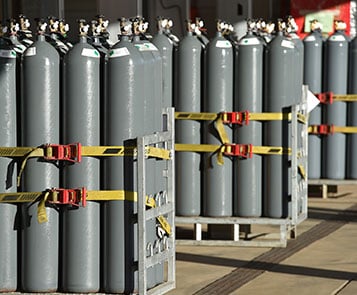Biological Safety Cabinet Airflow for Labs: Ducts and More
One major consideration for lab and production managers and designers is how the airflow from their biological safety cabinets (BSC) will impact and interact with the lab’s overall ambient conditions.
Most lab pros know that when designing and implementing a lab layout, it’s crucial to follow all relevant federal, state, or local regulations. Unfortunately, when setting up or operating, lab managers often overlook BSC airflows. By not optimizing biological safety cabinet airflow, organizations increase the risk of appliance cross-contamination and more. 
What Are Some of the Factors Around Proper Biological Safety Cabinet Airflow?
Several systems and processes can potentially impact the airflow in and around BSCs and similar appliances. They include:
- Heat sources (machines, radiators, and the like)

- Air ducts
- Exits/entries

- Types of work
- Density of BSCs and other appliances
- Air conditioning/fans
 Why Ventilation for BSC Airflow Is Important
Why Ventilation for BSC Airflow Is Important
 What are the reasons for ensuring proper ventilation in the laboratory, and how do we achieve this? The layout and operation of the BSCs and other appliances, such as fume hoods, are significant factors. Then there are ducts that expel air and waste, which can have a substantial impact on workplace safety.
What are the reasons for ensuring proper ventilation in the laboratory, and how do we achieve this? The layout and operation of the BSCs and other appliances, such as fume hoods, are significant factors. Then there are ducts that expel air and waste, which can have a substantial impact on workplace safety. 
These are details administrators might overlook—but the long-term repercussions can be major—risking safety, efficiency, and compliance in R&D and production labs. This is especially true when facilities have multiple BSCs (or other appliances) operating in close proximity.
What Are the Effects of Bad Ventilation in the Laboratory?
Proper lab airflow is crucial to keep poisons, gases, exhaust, and other BSC byproducts (along with any other substances) away from workers, sensitive experiments, sterile processes, and more. By reducing power consumption and implementing best airflow practices, overall lab efficiency improves.
Lab real estate planning and design failure can have serious BSC operational consequences, such as:
Noncompliance status with key standards: Failure to comply with standards opens organizations to risk—as well as potential citations and fines. The guidelines include those from NSF International, the American National Standards Institute (ANSI), and the American Society of Heating, Refrigerating, and Air-Conditioning Engineers (ASHRAE).
The relevant statutes include: 
- The NSF/ANSI 49-2024 standards for BSC design, construction, and performance

- The ANSI/ASHRAE 110-2015 guidelines for laboratory fume hood performance, which assess containment and safety
It’s crucial that administrators ensure they support these rules and promote biological safety cabinet airflow best practices. 

Risking team member exposure: Increasing particle density in critical work zones seriously endangers employees. For instance, if team members lack masks, they are at risk of inhaling contamination, and potentially causing lung and other internal damage. If they lack googles or other external protections, their eyes and skin are at risk.
Causing workflow disruption: Exposure to unfiltered air or the disruption of laminate flow can contaminate samples—and force staff to discard them. This means team members must repeat projects and processes, which slows R&D and production, and costs valuable resources, such as time.
Introducing operational inefficiencies: If the lab's airflow design or overall facility layout has gaps or is substandard, it can lead to major operational problems. That is because the various ventilation systems (fans and other gear) must operate near or at full capacity just to keep the air pure. When this occurs, the ventilation processes consume excess electricity. 
Operational flaws can also cause the various ventilation systems and components to wear out more rapidly. Additionally, with the system running at full capacity, the surrounding worksite can overheat. In turn, the machines that are furthest away from ducts or fans will require additional cooling, and this leads to a vicious cycle of excess power consumption just to maintain a workable environment.
Best Practices for Biosafety Cabinet Lab Layout
When maintaining biological safety cabinet airflow best practices, managers and administrators should ask themselves the following key questions:
Are there ways organizations can improve biological safety cabinet airflow?
Yes. To summarize, substandard lab airflow management is a poor practice that can result in wasted time, money, worker productivity, and more. Fortunately, best practices can assist managers to properly arrange the worksite layout—while positioning the BSCs, fume hoods, and other equipment in ways to complement the planned lab ventilation and airflow.
Where should we site an appliance to ensure the best biological safety cabinet airflow? 
When considering the ideal lab and workplace environment for optimal biological safety cabinet airflow, organizations should ensure the appliances are sited:
In clean, dry, and well-ventilated areas: The cabinet requires a surrounding work area with clean, dry, and contaminant-free air. Additionally, well-ventilated labs with proper exhaust systems are essential to prevent any accumulation of hazardous fumes or biological agents. The space selection and preparation should ensure there is no risk of cross-contamination between any BSC’s work area and other lab sections.
In relatively quiet zones: Planners should site the BSC away from adjacent high-traffic areas to avoid workflow disruptions. People moving in, around, and out of the lab can disturb the various airflows, leading to potential exposure or contamination risks. Ideally, managers should place BSCs in quieter lab areas, or in designated—and specially protected—biosafety zones.
On flat, stable surfaces: Uneven surfaces tilt the appliances. This can cause airflow disturbances that compromise the cabinet’s performance and safety. To maintain appliance airflow system stability, the machine should only reside on flat, smooth floors or surfaces.
In open spaces—with sufficient surrounding clearance: Overcrowding or obstructing the airflow around the cabinet can affect its filtration and containment capacity. Administrators must ensure there is enough space around the cabinet for air to circulate freely. This includes proper spacing adjacent to the BSC’s rear and sides. 

 Are there places to avoid placing a BSC?
Are there places to avoid placing a BSC?
Managers should also be aware of where not to locate their appliances. Below, we list some of the sites and zones where the appliances are at risk of substandard operations. Lab managers should avoid placing BSCs near:
Frequently used doors: Whenever a door opens and closes, and a worker enters or exits an area, there is the risk of airflow disturbance. This reduces the cabinet’s ability to maintain a sterile environment, increasing the risk of external contamination. 
Windows or air vents: These and other air flow sources can cause fluctuating air pressure and drafts in the lab. This could directly interfere with a BSC's operation. The appliances rely on stable and directional airflow to filter and contain potentially hazardous particles. So, managers should ensure that cabinets are placed away from windows or vents that blow in drafts from outside the work area.
Heat sources: Above-room-temperature heat can affect the cabinet’s functioning—and even compromise biological work safety. So, avoid siting the BSC near radiators, heaters, or other heat-conducting or generating systems.
Heating, ventilation, and air conditioning (HVAC) units: The cabinets rely on laminar flow to maintain a sterile environment. Any air-related disruption can compromise a BSC's protective airflow and its containment features. So, don’t site them near fans, or air conditioning vents (or similar air flow control systems) that generate any high turbulence and lab drafts. For instance, if a BSC is too close to supply or exhaust vents, its drafts can disturb air flows inside the appliance. This can strain the cabinet’s internal filtration system, making it difficult to maintain proper containment.
Crowded and overloaded spaces where there is a lot of commotion: A cluttered workspace can hinder both airflow and ease of worker access to the appliance—two BSC operations essentials. Therefore, avoid placing a cabinet in areas that are overcrowded with equipment, materials, or other laboratory furniture. Sudden or quick movements, whether by lab personnel or animals, can disturb the airflow patterns in a BSC. The motion turbulence can disrupt the carefully controlled laminar flow of air inside the cabinet. This is why it’s important to minimize sudden movements and distractions near the BSC when it's in use.
What things could disrupt biological safety cabinet airflow?
Obstruction of the cabinet’s intake and exhaust vents: To maintain proper airflow, BSCs rely on a system of intake and exhaust vents. Any vent obstruction or blockage—by lab equipment, containers, or even excessive debris—interferes with proper airflows. This applies both to the air intake and exhaust slots—if anything is too close to either, it can create airflow irregularities or turbulence. This causes the filtration systems to lose power, creating recirculating air zones in the cabinet and leading to contamination. However, staff can avoid this by keeping their workspaces clean and by avoiding placing objects too close to the internal vents.
Allowing filters to become clogged or dirty: Over time, a BSC’s crucial high-efficiency particulate air (HEPA) filters become clogged with particulate matter or common laboratory contaminants. This reduces their ability to filter air efficiently, so staff members must perform regular maintenance, and address BSC certification requirements. They must also replace filters as needed so the appliances operate at peak performance levels.
Internal ventilation malfunctions: Some appliances may have substandard internal ventilation or airflow imbalances. Such BSCs will start to draw on the external airflows from the facility’s HVAC resources. This can affect the overall facility conditions—meaning some workspaces and appliances will receive inadequate ventilation. This raises the contamination risk for sensitive gear or processes.
Disruptive excessive airflows: Sometimes, appliances malfunction internally and eject air jets directly into the lab environment. These airflow spouts, if strong enough, can travel across the workspace, reaching other equipment, workstations, or even other BSCs in the vicinity. When this occurs, the air jets may also carry contamination from the appliance, ejecting them. This could increase the risk of cross-contamination, especially in areas where multiple cabinets operate simultaneously.
Workplace pressure imbalances: To ensure the containment of hazardous materials, many labs are designed to maintain a specific pressure balance. BSCs can affect the containment and pressure control systems in a work area—so the appliances must all be sited properly and working in top order. If a BSC has a disruptive airflow event, it can cause overall pressure imbalances in the surrounding room. Potentially, this leads to hazardous air being drawn into—or vented out of—the lab.
Can substandard airflow in cabinets affect the lab or workspace overall?
Yes, internal appliance airflow disturbances affect the air quality and flow around the broader laboratory or production environment. Below are two risks:
Cross-contamination: This occurs when an appliance’s airflow is compromised. Such a BSC or other machine could force out contaminated air into the surrounding environment—exposing personnel to hazardous materials and infiltrating other areas and processes.
Aerosol leaks: An unbalanced airflow in the cabinet can cause aerosol leaks, contaminating the lab’s air, surfaces, and other equipment.
Are there steps we can take for proper ventilation and BSC airflow?
Fortunately, yes. Improper planning of biological safety cabinet airflow can have severe consequences. It can mean that organizations discover too late that their appliances are performing substandard, or are in a negative ambient condition. And addressing airflow shortcomings or errors on the fly, reactively, can require extra time, money, and effort.
A good first step for success is to be proactive. Managers, administrators, or designers who must oversee proper lab and workspace safety should plan in advance, and thoroughly. This is a great way to ensure an organization’s biological safety cabinet airflow meets industry standards and best practices benchmarks. We'll review these measures below:
Administrative Preparations to Support Biological Safety Cabinet Airflow
Start planning early: As far in advance as possible of the lab relocation/buildout project, make plans. Managers must be sure they acquire the necessary resources to ensure proper biological safety cabinet airflow. This includes assembling the team members, gathering information, and setting goals for the project.
Pick a stakeholder project oversight team: These people will oversee all aspects of planning, design, and execution. To be comprehensive in enabling optimum biological safety cabinet airflow design, consider including:
- Operational staff
- Principal investigators
- Architects
- Engineers
- Safety officers
Power, Design, and Tech Standards for Biological Safety Cabinet Airflow
There are technical considerations in play, as well, and managers should think about how they can:
Incorporate key standards in planning: Stakeholders must bake in certain industry standards when it comes to biological safety cabinet airflow. Two standards are necessary:
- NSF/ANSI 49-2024: This ensures the appropriate layout design for the BSCs—and that planners locate them to minimize cross-contamination and maximize safety.
- ANSI/ASHRAE 110-2015: This will optimize fume hood placement and support airflow performance validation.

Some codes ensure proper airflow in biological safety cabinets. These are essential for safety, as well as to prevent failed audits and fines. They include:
- Fire safety codes
- Local building codes
- Regional/municipal lab design requirements
Target potential contamination: It’s essential to arrange BSC/fume hood installations to avoid any potential cross-contamination from any source. This way, the lab design will be free from potential:
- Turbulence from poor airflow or HVAC system interference
- Incorrectly calibrated BSCs or poorly maintained equipment
- Dust and particulates entering through unsealed or improperly filtered areas
Address appliance, hardware, and technical requirements for biological safety cabinet airflow: There are also appliance-specific airflow considerations. Managers must factor in:
- Appliance placement/spacing requirements: The appliance must not cause airflow disruptions. So, the BSCs and fume hoods must be separated at fixed distances from HVAC ducts and high-traffic areas.
- Electrical needs: Designers must ensure that there will be enough energy for appliances and ventilation systems (such as fans) without overburdening power sources.
- Immediate work areas: The biological safety cabinet airflow will, to some degree, depend on the lab infrastructure. The means factoring in the lab’s height and width; its neighboring work areas (both those connected in an open space or segregated by walls), storage areas; and so on.
- The overall facility: The team must consider the entire lab and the surrounding workplaces when planning. The ventilation, power, and other systems will likely be shared with adjacent rooms, labs, and so on. Planners must also factor in what floor the lab is on; how it impacts other building residents; and similar dependencies.
After initial plan execution, must we revise our layout/operations to ensure biological safety cabinet airflow remains optimal?
Yes. The BSC area airflow performance requires constant vigilance and maintenance. Fire department, OSHA, and other auditors may visit regularly—so managers must proactively ensure no compliance gaps have appeared. The organization must proactively establish protocols for the continued monitoring and validation of airflow performance per ANSI/ASHRAE 110-2015. This will ensure continued safety and compliance with the biological safety cabinet airflow.
Consider Partnering With Biological Safety Cabinet Airflow Experts
As we’ve seen, designing and executing a compliant, efficient, and safe biological safety cabinet airflow plan is complex. This comes in addition to planning and making preparations for BSC certification and decontamination service programs.
Ultimately, the complexities of BSC placement and operations, along with overall lab design and compliance, can be overwhelming. This is where Triumvirate Environmental can help. As subject matter experts in laboratory design and safety compliance, we ensure adherence to critical standards like NSF/ANSI 49-2024 and ANSI/ASHRAE 110-2015.
During the workplace design and planning phase, our team members identify potential challenges to maintaining proper airflow in biological safety cabinets. They offered tailored solutions to optimize airflow, safety, and operational efficiency. By working with us, you’ll save time and money while ensuring your lab meets all regulatory requirements.
With expert guidance and thoughtful planning, you can create a compliant lab environment. Your facility will also be safe, efficient, and help promote an innovative mindset and culture. This will remove the biological safety cabinet airflow burden from your staff and managers. We also provide biological safety cabinet certification and decontamination services. Contact us today to learn how we can assist you.






